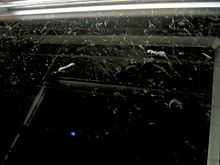Particle detector

In experimental and applied particle physics, nuclear physics, and nuclear engineering, a particle detector, also known as a radiation detector, is a device used to detect, track, and/or identify high-energy particles, such as those produced by nuclear decay, cosmic radiation, or reactions in a particle accelerator. Modern detectors are also used as calorimeters to measure the energy of the detected radiation. They may also be used to measure other attributes such as momentum, spin, charge etc. of the particles.
Description
Detectors designed for modern accelerators are huge, both in size and in cost. The term counter is often used instead of detector, when the detector counts the particles but does not resolve its energy or ionization. Particle detectors can also usually track ionizing radiation (high energy photons or even visible light). If their main purpose is radiation measurement, they are called radiation detectors, but as photons are also (massless) particles, the term particle detector is still correct.
Examples and types
Many of the detectors invented and used so far are ionization detectors (of which gaseous ionization detectors and semiconductor detectors are most typical) and scintillation detectors; but other, completely different principles have also been applied, like Čerenkov light and transition radiation.

Historical Examples
- Bubble chamber
- Wilson cloud chamber (diffusion chamber)
- Photographic plates
Detectors for Radiation Protection
The following types of particle detector are widely used for radiation protection, and are commercially produced in large quantities for general use within the nuclear, medical and environmental fields.
- Gaseous ionization detectors
- Geiger-Müller tube
- Ionization chamber
- Proportional counter
- Scintillation counter
- semiconductor detectors
- Dosimeters
- Electroscopes (when used as portable dosimeters)
Commonly used detectors for Particle and Nuclear Physics
- Gaseous ionization detectors
- Ionization chamber
- Proportional counter
- Multiwire Proportional Chamber
- Drift chamber
- Time projection chamber
- Geiger-Müller tube
- Spark chamber
- Solid-state detectors
- semiconductor detectors and variants including CCDs
- solid-state track detectors
- Cherenkov detector
- RICH (Ring Imaging Cherenkov Detector)
- Scintillation counter and associated Photomultiplier or Photodiode / Avalanche photodiode
- Semiconductor detector
- Silicon Vertex Detector
- Transition radiation detector
- Calorimeters
- Microchannel plate detectors
- Neutron detectors
Modern detectors
Modern detectors in particle physics combine several of the above elements in layers much like an onion.
Installations of particle detectors
At colliders
- At CERN
- At Fermilab
- At DESY
- At BNL
- for the RHIC
- PHENIX
- Phobos (physics)
- STAR
- for the RHIC
- At SLAC
- At Cornell
- At BINP
- Others
- MECO from UC Irvine
Under construction
Without colliders
On spacecraft
See also
References
External links
- Filmstrips
- "Radiation detectors". H. M. Stone Productions, Schloat. Tarrytown, N.Y., Prentice-Hall Media, 1972.
- General Information
- The Particle Detector BriefBook
- How to Build a Cloud Chamber
- Grupen, C. (June 28-July 10, 1999). "Physics of Particle Detection". AIP Conference Proceedings, Instrumentation in Elementary Particle Physics, VIII 536. Istanbul: Dordrecht, D. Reidel Publishing Co. pp. 3–34. doi:10.1063/1.1361756.